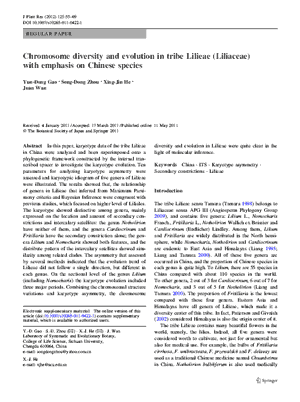NEWS 2012
Chromosome diversity and evolution in tribe Lilieae (Liliaceae) with emphasis on Chinese speicies
Yun-Dong GAO, Song-Dong ZHOU, Xing-Jin HE, Juan WAN
Journal of Plant Research, 125: 55-69 (2012)
Laboratory of Systematic and Evolutionary Botany, College of Life Science, Sichuan University, Chengdu 610064, CHINA
Abstract
In this paper, karyotype data of the tribe Lilieae in China were analyzed and been superimposed onto a phylogenetic framework constructed by the internal transcribed spacer to investigate the karyotype evolution. Ten parameters for analyzing karyotype asymmetry were assessed and karyotypic idiogram of five genera of Lilieae were illustrated. The results showed that, the relationship of genera in Lilieae that inferred from Maximum Parsimony criteria and Bayesian Inference were congruent with previous studies, which focused on higher level of Liliales. The karyotype showed distinctive among genera, mainly expressed on the location and amount of secondary constrictions and intercalary satellites: the genus Notholirion have neither of them, and the genera Cardiocrinum and Fritillaria have the secondary constriction alone; the genera Lilium and Nomocharis showed both features, and the distribute pattern of the intercalary satellites showed similarity among related clades. The asymmetry that assessed by several methods indicated that the evolution trend of Lilieae did not follow a single direction, but different in each genus. On the sectional level of the genus Lilium (including Nomocharis) the karyotype evolution included three major periods. Combining the chromosomal structure variations and karyotype asymmetry, the chromosome diversity and evolution in Lilieae were quite clear in the light of molecular inference.

